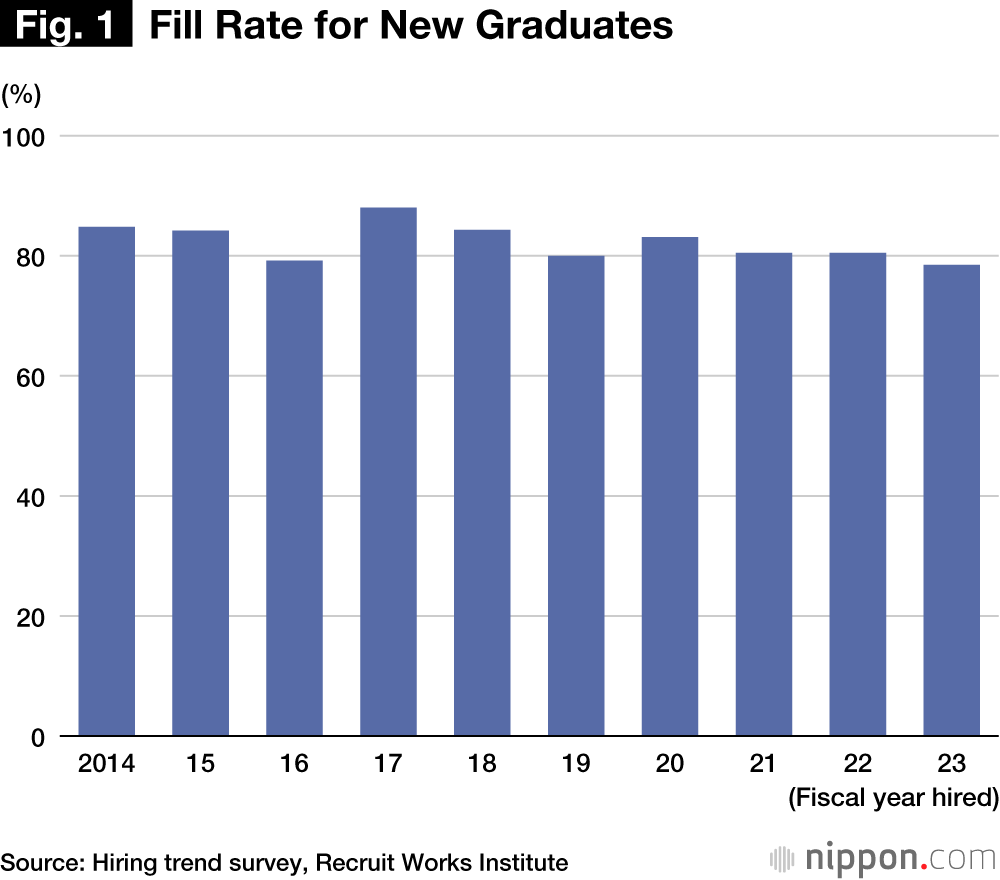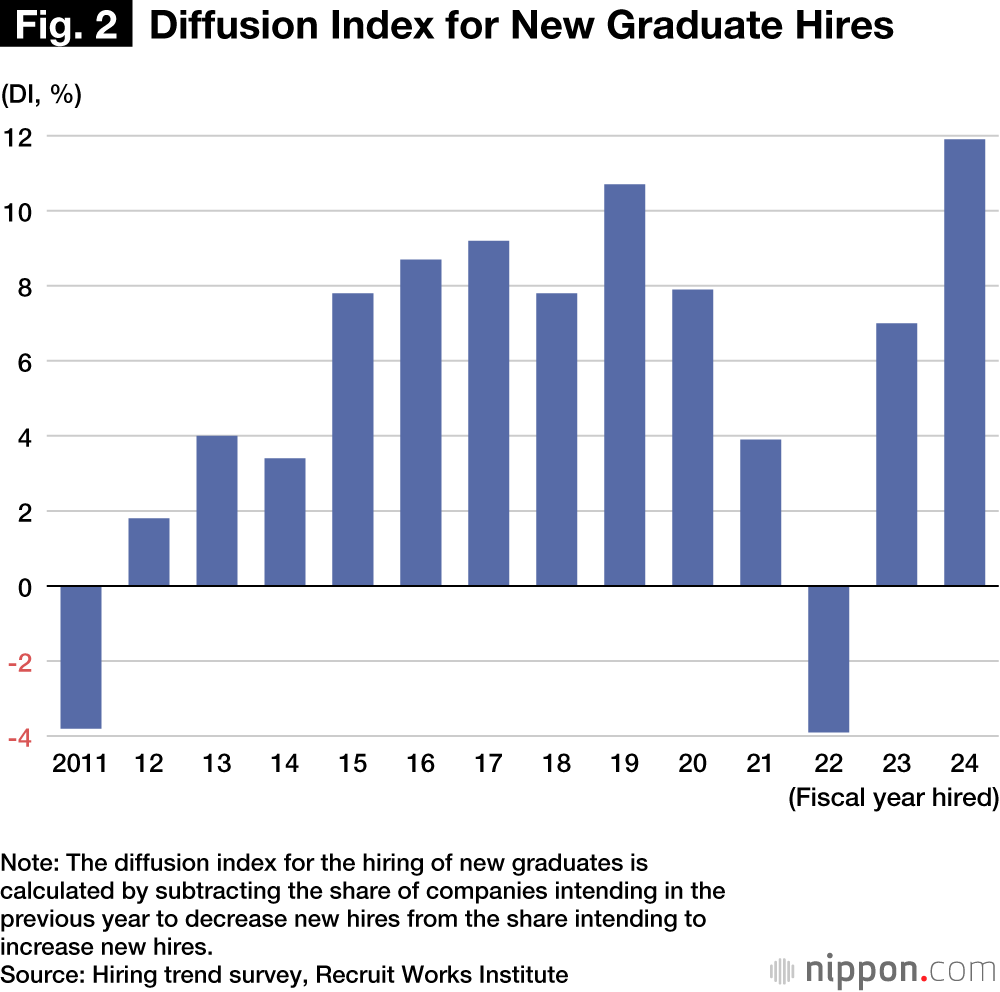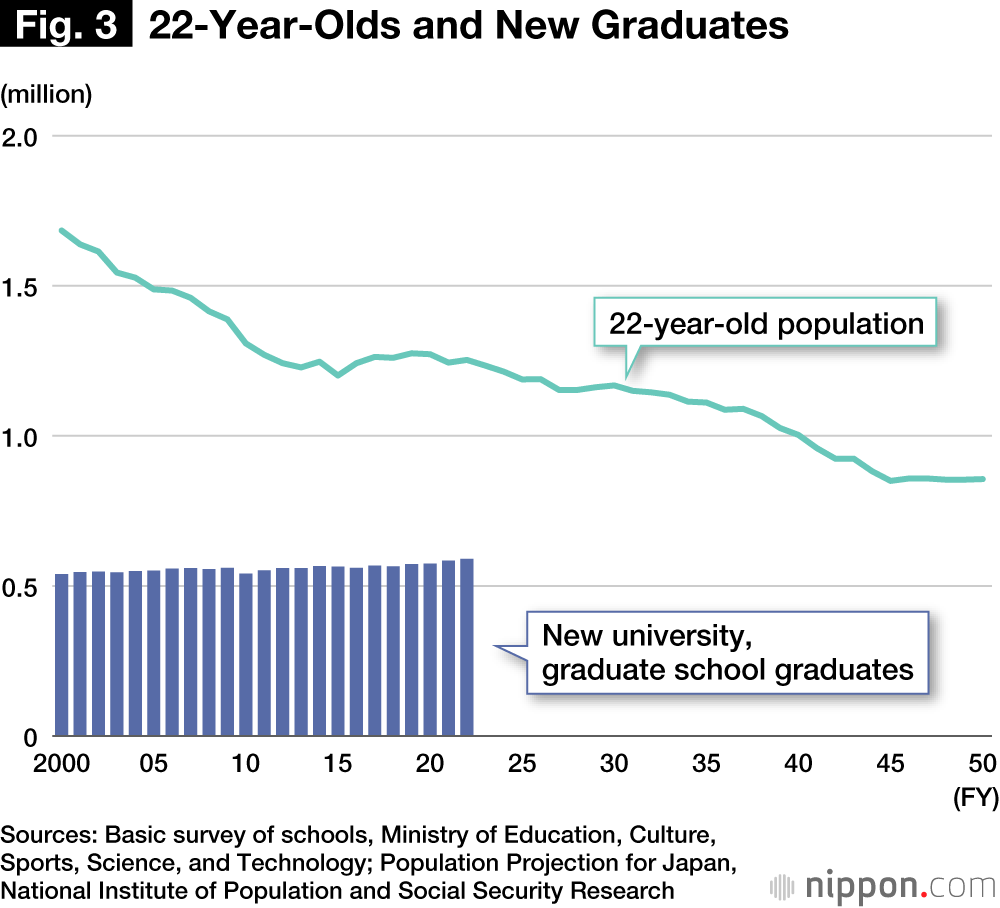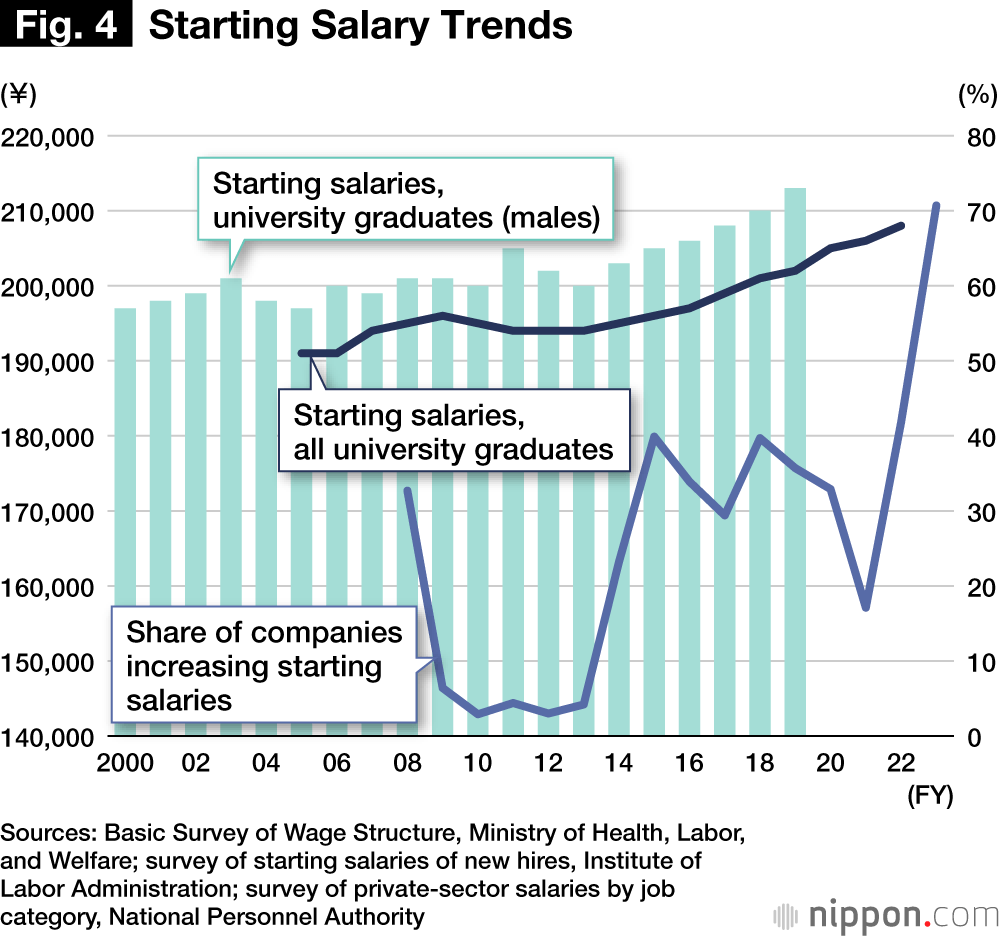
New Grad Hiring Rates Fall as Starting Salaries Climb
Economy- English
- 日本語
- 简体字
- 繁體字
- Français
- Español
- العربية
- Русский
New Graduate Hiring Is Trending Downward
The 2023 shuntō, or spring wage offensive, of 2023 has resulted in record-setting wage increases. Many companies have also made large increases to starting salaries. To what degree have the starting salaries of new graduates risen? And how can these salaries be expected to trend going forward?
The Recruit Works Institute publishes an annual survey of companies’ hiring outlook for new graduates. In this nationwide survey, private-sector companies with five or more employees are interviewed by telephone. In the most recent survey for 2022, 7,200 companies were contacted and 4,341 companies responded.
To confirm whether the hiring of new graduates of universities and graduate schools occurred as planned, companies are asked the number of new graduates they intended to hire as of April of the previous year and the number of prospective hires as of October 1 of the same year. Dividing the latter, or prospective hires, by the former, or intended hires, yields the fill rate. This rate was 78.5% for new graduates graduating in 2023, the lowest figure recorded in the 10 years since 2014 when the survey began (Figure 1). The share of companies that are unable to hire according to initial plans has gradually increased in recent years. As a result, companies wanting to hire new graduates but are unable to do so are also thought to be on the rise.
Regarding the fill rate for 2023 graduates by company size, this rate was 98.7% for companies with 5,000 or more employees (100.4% in the previous year), 90.1% for companies with 1,000 to 4,999 employees (96.3%), 84.8% for companies with 300 to 999 employees (90.7%), and 65.5% for companies with 5 to 299 employees (65.9%). We can see that the trend of smaller companies being unable to hire as intended is continuing, hitting the smallest companies the hardest. We can also see that this is spreading to medium-sized companies.
Strong Corporate Hiring Interest
A factor contributing to the downward trend of the fill rate is companies’ increased interest in hiring. The hiring outlook survey includes a diffusion index on the outlook for hiring new graduates of universities and graduate schools for the fiscal year following the survey (this would concern those graduating in spring 2024 for the survey of autumn 2022). This index is calculated by subtracting the share of companies anticipating a decrease in new hires from the share of companies anticipating an increase. In the most recent survey, the diffusion index is 11.9%, indicating that companies’ interest in hiring new graduates has strengthened in recent years, excepting the years influenced by the pandemic (Figure 2).
As depicted in Figure 3, the number of new graduates has gradually increased in the last 10 years. New graduates totaled 559,000 in 2012 but rose to 590,000 in 2022, which has supported companies’ vigorous hiring in recent years.
The gradual ascent of the university entrance rate is enabling the number of new graduates to grow. In 2022, the university entrance rate marked a record high of 56.6%. Another contributing factor is the number of 22-year-olds in the population remaining more or less flat. The children of the baby boomer generation are now around 50 years old, and their children have reached the age of seeking employment. These factors stand behind the pause in the decline of young people in the population and the continuing high number of new graduates.
Examining the market for new graduates in terms of supply and demand, as supply holds steady, companies’ demand for new graduates is rising in the midst of a labor shortage. Moreover, strongly reflecting this increase in demand, the fill rate is continuing to decline.
Growth in Starting Salaries
According to market principles, a tight supply-demand balance will naturally become manifest as higher wages. In fact, the starting salaries of new graduates has been rising in recent years.
In its Basic Survey of Wage Structure, the Ministry of Health, Labor, and Welfare surveys the starting salaries of men and women each year. This survey shows that the starting salaries of male university graduates have generally trended flat since 2000 (monthly salary of ¥197,000). Since the first half of 2010, however, starting salaries have clearly turned upward (Figure 4). A starting monthly salary of ¥200,000 in 2012 had risen to ¥213,000 monthly as of 2019. The survey of starting salaries was halted in the Basic Survey in 2019, and such data has not been collected since 2020. However, the National Personnel Authority also surveys the starting salaries of university graduates in its survey of private-sector salaries by job category, which it uses to determine the salaries of government workers. This survey indicates that wage increases have continued since 2020.
The latest trend for starting salaries can be confirmed in the salary survey of new hires of the Institute of Labor Administration, which reveals that the trend to offer higher starting pay is broadening. This survey is restricted to companies listed on the Tokyo Stock Exchange Prime Market, and is limited by a relatively low response rate (in the fiscal 2023 survey, 157 companies out of 1,784 responded). While bearing these limitations in mind, the share of companies that increased starting salaries rose to 70.7% in fiscal 2023. Clearly, the current ascent of starting salaries stands out against previous years.
As discussed above, starting salaries have been moving upward since the first half of the 2010s, a trend that is currently accelerating. This basically reflects the tight supply-demand balance of the market for new graduates. It is reasonable to think that this competitive environment is causing companies to raise starting salaries. The National Institute of Population and Social Security Research anticipates that the number of 22-year-olds in the population will trend downward going forward. In view of the future supply and demand situation for the hiring of new graduates, companies are likely to find it increasingly difficult to hire new graduates even if they want to do so.
Will Salary Increases Continue to Accelerate?
How can the hiring of companies be expected to change in the years ahead? More and more companies are likely to shift to hiring midcareer personnel, since the mass hiring of new graduates no longer meets their staffing needs. As a result, companies are expected to gradually reduce the share of new graduates in their hiring of personnel.
Even as companies reduce the share of new graduates hired in mass in their total hiring, they will still continue to hire fresh grads. Competition will therefore intensify over the hiring of these young people. Companies able to secure needed personnel through the hiring of new graduates will be limited to a small number of popular companies, and other employers will be forced to shift to the hiring of midcareer personnel and to develop comprehensive hiring plans to secure the people they need.
Based on the above, what can be expected of starting salaries in coming years? Their rate of increase is likely to gradually accelerate. While this will naturally benefit young people of the future, it will also place increasing strain on companies’ profit structures.
This prospect is not limited to the hiring of new graduates. Should a tight labor market cause wages to rise, the profits of companies will decline unless they change their ways of doing business. In the economy of coming years, this pressure from the labor market can be expected to promote such management efforts as capital spending and the reform of business processes.
Those businesses unable to keep up with the ascent of wages in the labor market will be forced out of the market. Will labor market pressure result in the increase of real wages? It will bear watching whether this mechanism will work in a healthy manner and whether improvements in corporate productivity will spread throughout society. Whether the increase of wages will lead to the improvement of living standards will depend on the promotion of economic renewal in an environment of labor shortages, as well as on enhancing the productivity of the economy as a whole.
(Originally published in Japanese. Banner photo: At a ceremony welcoming newly hired employees at Nissan Motor, which took place in Yokohama on April 3, 2023, in person for the first time in four years, newly hired employees affix notes to a board showing the images they have of themselves 10 years in the future. © Jiji.)



